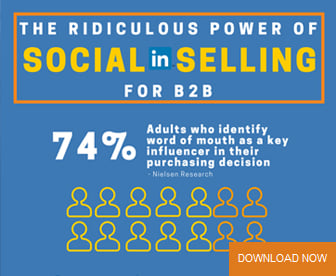Four Steps for Making Sure Your Content Is Read
Many of today’s marketers lack the time and, often, the ability to generate quality content to help their brands. Once they do manage to create content, they can have difficulty getting the right eyes — or any eyes — to read it. This is, in part, due to a fundamental shift in recent years in the habits of media consumption.
According to 2016 research done by Pew Research Center, 62 percent of adults get their news through social media. Not only are social media sites, like Facebook, Twiiter, and Reddit, becoming sources for B2B news, the research also shows that users of sites like LinkedIn more actively seek out news, as opposed to simply happening upon it: 51% of LinkedIn’s reported 450 million users actively seek out news on the platform.
As news consumption is moving to social media, ClickZ reports that homepages become less important for readers, and that, “it’s OK to accept that the traffic is directed differently nowadays.” Coupled with findings from DMR showing the increase in LinkedIn member page views from 37 billion in Q4 2015 to 45 billion in Q1 2016, the writing is on the wall.
At the same time, there’s been a shift in how consumers feel about marketing messages from strangers versus those from trusted sources, or influencers. Collective Bias, a company specializing in influencing campaigns for brands and retailers, performed a recent study that underscored the value of influencer-based content. Results showed that consumers view content from influencers seven times longer than a digital display ad (two minutes, eight seconds versus 19.2 seconds). In short, consumers trust content from sources they know and respect. Thankfully, your organization is probably full of trusted influencers ready to be leveraged.
This might all feel overwhelming to a busy marketer and, yet, all of these changes must be taken into consideration if you want your content to not just be consumed, but to also resonate. Luckily, this can be accomplished in a few simple-to-follow steps.
Step 1 — Identify and create “quality” content
The days of press releases being a lone source of information about a company are long over. Yes, news still has its place, but there is a hunger for higher quality, higher value content. Case studies perform the function of explaining how your company can help your target audience, but are told through the experiences of satisfied customers or partners. The end result is intended to be a piece that has readers connecting how they, too, could benefit from such a product or service. In short, case studies resonate without coming across like a blatant sales pitch, because they are told by a third party.
White papers can boost your brand’s cachet by addressing complex or important topics and making it clear that your product/service is a leader. Additionally, by contributing to trade publications and industry newsletters, one can also increase not only brand awareness, but positioning as a thought leader.
Finally, videos can be a powerful form of content to help tell compelling stories and share your message.
Each of these different content types can appeal differently to target audiences. Therefore, a mixed approach is often best. With some strategic planning, it’s often possible to utilize one piece of content in multiple formats. For instance, a video of a customer sharing a testimonial can be easily written into case study form. Alternatively, white papers often contain enough content to be turned into separate talking points for contributed articles and blogs.
Step 2 — Understand how people consume media today
Gone are the days of print media being the only source of distribution. Additionally, simply posting content to your website will often end with poor results. I’m not suggesting those avenues have been or should be abandoned, but they should be supplemented with more powerful mechanisms to spread content.
Social media is a great way to disseminate your content. Twitter, Facebook, and LinkedIn all have proven effective as content spreading machines. Look no further than the Pew Research Center study to see how powerful these platforms have become.
While it may be tempting to focus on one of these highly used sites to spread your marketing message, a more prudent course would be to use all of them, including ones lower on the Pew Research Center’s list, such as Instagram, Tumblr, and Youtube. Of course, never overlook the fact that the right type of content is needed to match the type of social networking site.
Step 3 – Don’t overlook mobile consumption
Further research by Pew Research Center shows that 72 percent of U.S. adults have received news on their mobile devices. While two-thirds of respondents said they get their news from both mobile devices and desktops/laptops, 56 percent said they prefer mobile.
Of course, we don’t need research to know this is the trend. Looking at your own media consumption, it’s a safe bet that a fair amount of reading and research is done on your mobile devices. Mobile web browsers and news aggregating apps can deliver very specific news in an easy-to-read format — hopefully.
When generating content on your site, ensure that content can be easily read on mobile devices. Ensure you have a responsive web design that allows text and content to be resized and reorganized to fit various sized screens and orientations. With so much traffic coming from mobile devices, they must be a significant part of your strategy. You don’t want to spend time creating content and driving traffic to your site, only to turn people away when they have difficulty reading it.
Step 4 — Leverage brand ambassadors
As mentioned earlier, while traditional marketing mostly relies on a sales and marketing team to spread your content, a new way of thinking called influencer engagement (or influencer communications) is having strong success due to the rise of social media. Influencer communications harnesses the social power of the people and departments within your organization, getting them to socially engage with customers and potential customers. Rather than rely on one person for marketing, this method employs the entire organization.
Consider how each executive has social ties, and how each member of the business development team is socially engaged with many customers and potential customers. Even your billing department most likely has relationships with customers. With a clear plan and course of action for employees, the content you create can be sent out by each employee using the above-mentioned social mediums, making use of those connections they already have.
Conclusion
By creating the right type of content and, at the same time, understanding where people are looking for content, you’ll be well on your way to getting your target audience to actually read what you produce. Additionally, by taking into account today’s propensity for reading on mobile devices, you further increase the chances it will be read. Finally, make use of your internal untapped resources to engage socially with your target audience. By following these steps, your content will get read.
Mostafa Razzak is Principal of JMRConnect, a public relations and influencer comminications firm, and the Mid-Atlantic Chairman for the Internet Marketing Association. Contact JMRConnect today to learn how its trademarked Shaping Influence™ approach connects brands to audience worldwide.
Edited by Erik Linask











